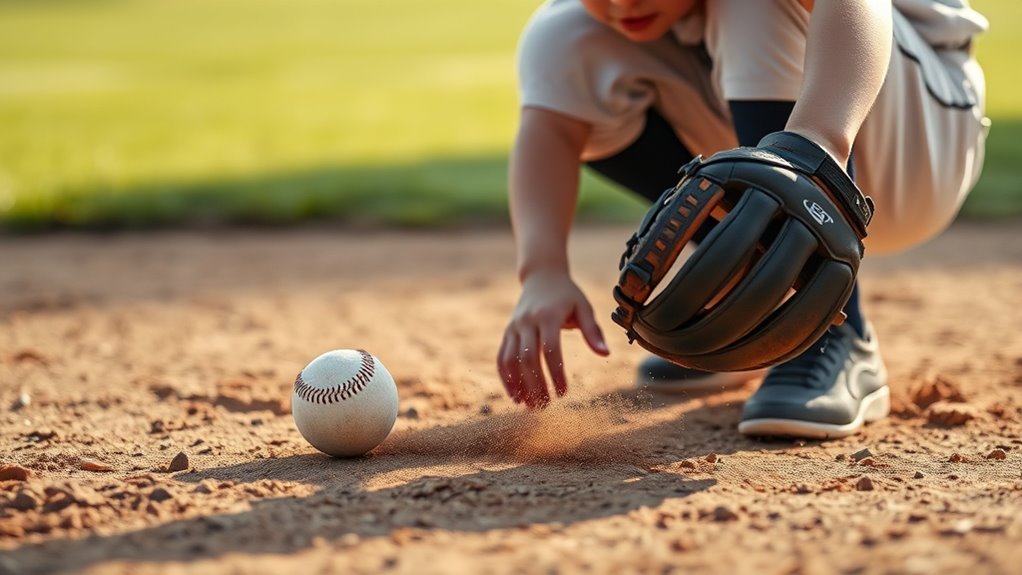To field grounders cleanly, start by positioning yourself properly with knees bent and weight centered, so you’re ready to move quickly. Keep your glove low and in front, focused on tracking the ball from contact to ground. Use your body to scoop the ball, engaging your legs and core for control. Practice quick footwork to improve your positioning, and stay calm and focused under pressure. Master these basics, and you’ll develop skills that make all the difference when handling grounders.
Key Takeaways
- Position your body properly with knees bent and weight centered for quick reactions.
- Keep your glove low and out front, ready to scoop and track the ball.
- Use your legs and core to move smoothly, not just your hand, to scoop grounders.
- Practice quick, precise footwork with agility drills to improve positioning.
- Stay calm and focused through breathing and visualization to make clean plays under pressure.
Position Yourself Properly for Ground Balls
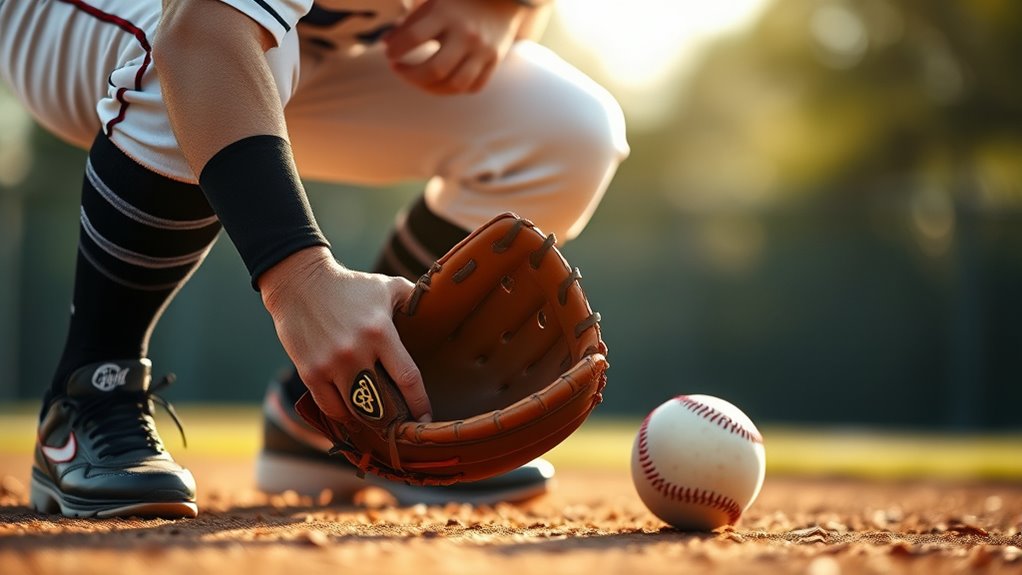
To effectively field ground balls, you need to start with the right positioning. Begin by establishing proper body alignment, with your knees slightly bent and weight centered over your feet. Your glove positioning should be low and out in front of your body, ready to meet the ball. Keep your eyes focused on the ball and move your body into the correct position early, so you’re prepared to move in any direction. Maintain a balanced stance, allowing quick reactions without losing control. Proper body alignment ensures you stay stable and agile, reducing errors. Adjust your glove positioning to match the ball’s trajectory, and always stay alert. This foundational setup helps you field grounders cleanly and efficiently, setting the stage for a successful play. Body positioning is also crucial for maintaining optimal balance and reaction time.
Keep Your Glove Low and Ready
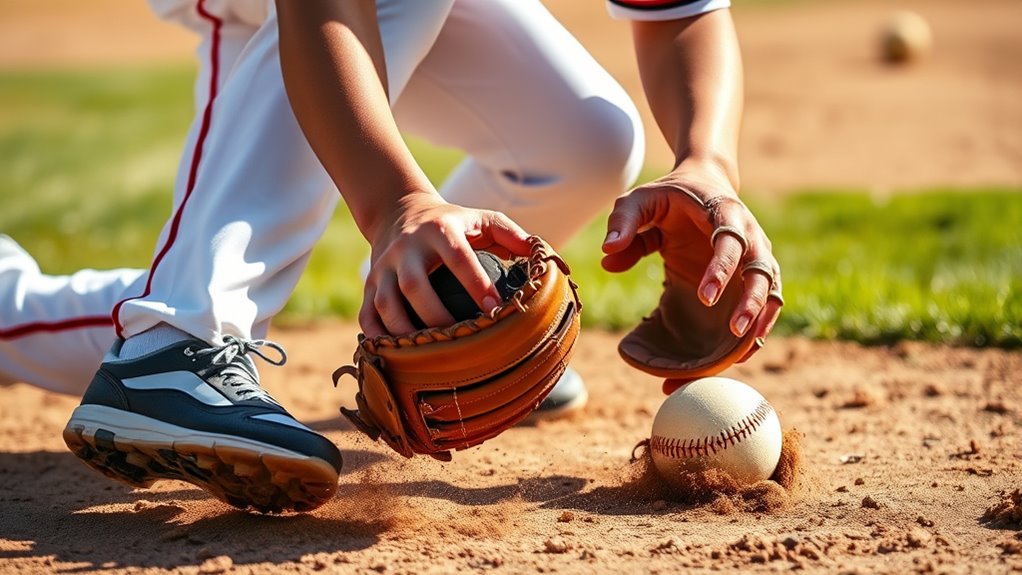
Keeping your glove low and ready is essential for quick and effective ground ball fielding. Proper glove positioning ensures you’re prepared to scoop the ball smoothly, reducing the chance of mishandling. Keep your glove close to the ground, about waist height, so you’re in a natural, athletic stance. This position allows for rapid reaction and minimizes movement, making it easier to field balls cleanly. Developing strong hand-eye coordination is key; focus on tracking the ball from the moment it’s hit. As the ball approaches, stay relaxed and keep your glove open and low, ready to scoop. This stance helps you react quickly, improves your chances of making a clean play, and sets the foundation for efficient, confident fielding. Additionally, understanding automation in business can help coaches and players implement training tools that adapt to individual skill levels, enhancing practice efficiency.
Use Your Body, Not Just Your Hand, to Scoop the Ball
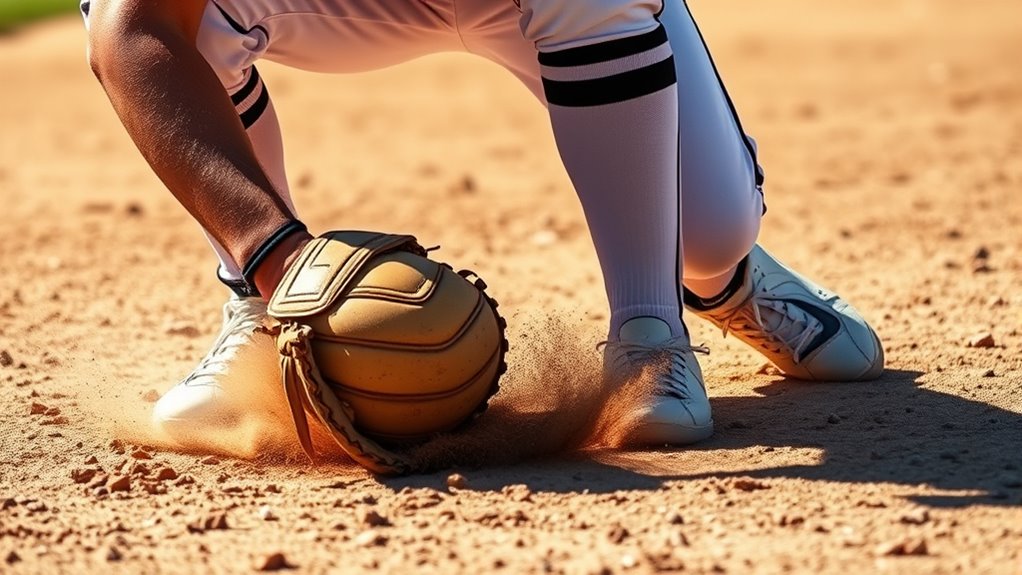
Using your body, rather than just your hand, adds power and control to your scooping technique. Proper body mechanics help you stay balanced and make quicker adjustments. Keep your glove positioned low and close to the ground, aligning it with the ball’s path. Engage your legs and core to scoop smoothly, rather than relying solely on arm motion. This helps transfer energy efficiently and reduces errors. Focus on moving your entire body toward the ball instead of just reaching out with your hand. Maintain a slight bend in your knees, ready to spring into action. Here’s a quick guide:
| Body Part | Key Action | Purpose |
|---|---|---|
| Legs | Bend and shift weight | Power and balance |
| Glove | Low, aligned with ball | Proper glove positioning |
| Core | Engage for control | Stability and quick movement |
Additionally, understanding body mechanics can significantly improve your fielding efficiency.
Practice Quick and Smooth Footwork
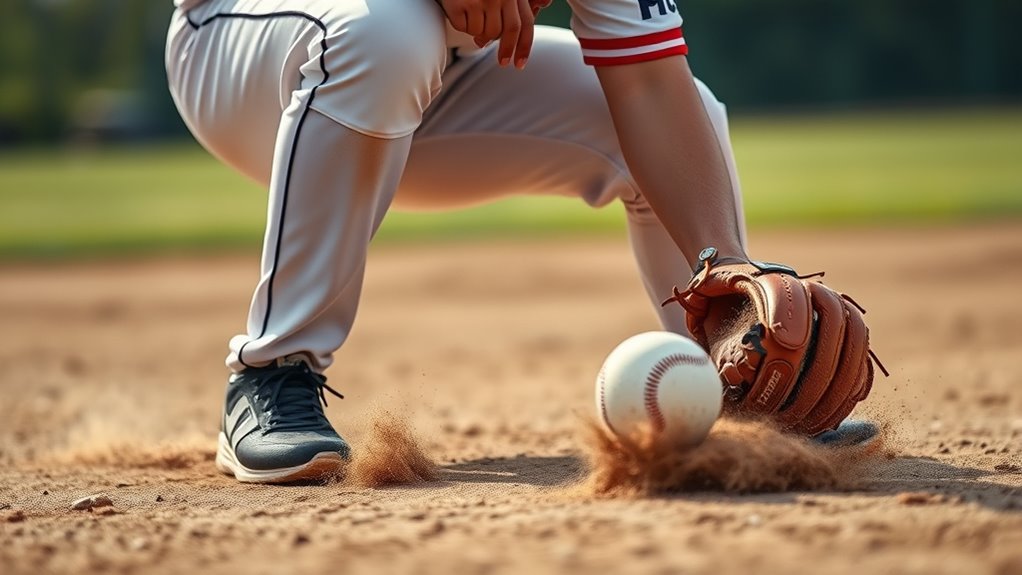
Mastering quick and smooth footwork is essential for effective fielding because it allows you to get into the right position swiftly and maintain control. To improve, focus on footwork drills that replicate real game scenarios, emphasizing quick, precise movements. Incorporate agility exercises into your training to boost your speed and coordination, making your transitions considerably smoother. Start with ladder drills to develop fast, accurate foot placement, then progress to cone drills that mimic grounder paths. Consistent practice helps build muscle memory, so your feet move effortlessly when the ball is coming at you. Remember, smooth footwork minimizes errors and positions you better for clean fielding. Proper footwork techniques are fundamental for improving your overall fielding efficiency. Dedicate time to these drills regularly, and you’ll notice your ability to handle grounders improves remarkably.
Stay Calm and Focused When Fielding
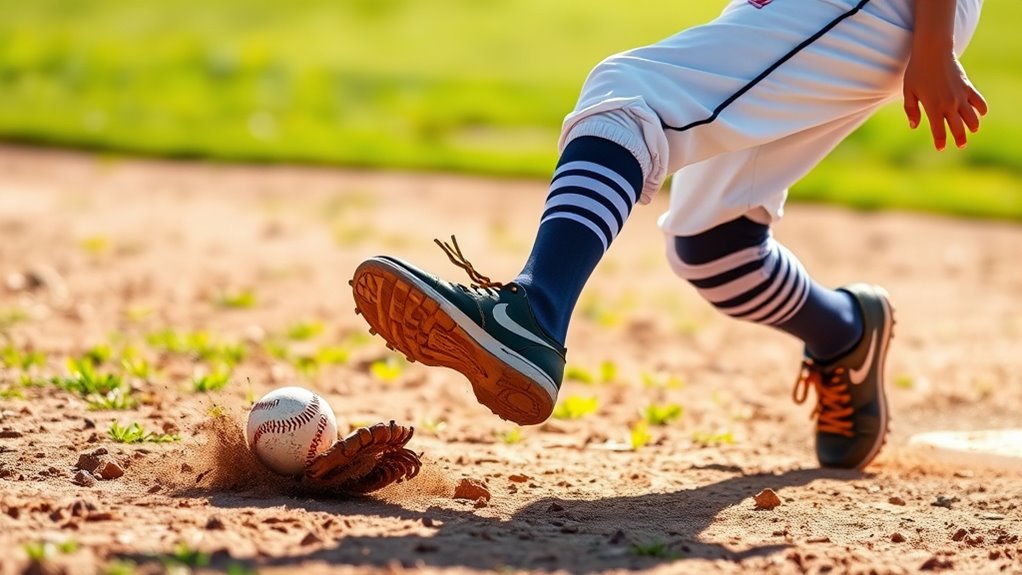
Staying calm and focused when fielding is essential because it helps you react quickly and make accurate plays under pressure. When your mental focus is sharp, you’re less likely to make mistakes. Use breathing techniques to stay centered; deep, slow breaths can reduce anxiety and improve concentration. Keep your mind in the present moment, avoiding distractions from crowd noise or past errors. Visualize successful plays beforehand to boost confidence. Remember to stay relaxed, with loose arms and knees slightly bent, so you’re ready to move swiftly. Practicing mindfulness techniques can further enhance your concentration during games.
Frequently Asked Questions
How Can I Improve My Reaction Time When Fielding Grounders?
To improve your reaction time when fielding grounders, focus on reaction time drills and quick reflex exercises regularly. These activities train your brain and body to respond faster to unpredictable plays. Incorporate short, intense drills like catching balls thrown from different angles or using reaction balls. Consistent practice enhances your instincts, helping you get to the ball sooner and field grounders more cleanly, ultimately boosting your overall defensive skills.
What Are Common Mistakes to Avoid When Scooping the Ball?
When scooping the ball, avoid common mistakes like poor glove positioning and a faulty fielding stance. Keep your glove low and ready, ensuring it’s square to the ground to catch the ball smoothly. Maintain a balanced, athletic stance with knees slightly bent, so you can move quickly and stay stable. Don’t reach or lunge; instead, move your feet to get into proper position for a clean scoop.
How Do I Handle Difficult or Unpredictable Ground Balls?
When facing difficult or unpredictable ground balls, stay alert to ground ball unpredictability and adjust quickly. Use solid glove work techniques like positioning your glove low and out in front, and keep your body in a ready stance. Move your feet to get into ideal positioning early, and don’t rush the play. Staying calm and focused helps you react better, ensuring you field the ball cleanly even under tough conditions.
What Drills Can Enhance My Infield Agility and Speed?
Think of your infield as a dancer preparing for a swift performance. You can boost your agility and speed with footwork drills that mimic game scenarios, like ladder exercises or cone shuffles. Incorporate agility exercises such as lateral quick steps and short sprints to sharpen your reactions. These drills improve your foot speed, balance, and coordination, helping you move seamlessly to field grounders and respond faster to unpredictable plays.
How Should I Position Myself Against Different Batter Types?
When facing different batter types, adjust your batting stance to anticipate their swings, staying balanced and ready to move. Position yourself with your glove placement aligned to where the ball is most likely to be hit, such as towards the backhand or forehand side. Stay alert and ready to shift your stance quickly, ensuring you’re prepared for line drives or grounders, giving you the best chance to field cleanly.
Conclusion
Mastering grounders is about positioning, readiness, and focus. Position yourself properly, keep your glove low and ready, use your body to scoop the ball, practice quick footwork, and stay calm under pressure. These fundamentals build consistency, confidence, and skill. By practicing these tricks regularly, you’ll improve your fielding and become a reliable part of your team. Remember, good fundamentals lead to successful plays, and success starts with your mindset and preparation.
